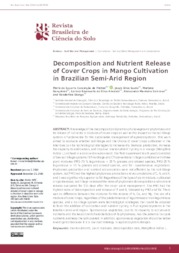Decomposition and nutrient release of cover crops in mango cultivation in Brazilian Semi-Arid region.
Decomposition and nutrient release of cover crops in mango cultivation in Brazilian Semi-Arid region.
Author(s): FREITAS, M. do S. C. de; SOUTO, J. S.; GONÇALVES, M.; ALMEIDA, L. E. da S.; SALVIANO, A. M.; GIONGO, V.
Summary: Knowledge of the decomposition dynamics of aboveground phytomass and its release of nutrients in mixtures of cover crops as well as the impact on the soil tillage system is fundamental for the sustainable management of agroecosystems. This work aimed to evaluate whether soil tillage and the choice of cover crops cultivated in the interrows can be technological strategies to increase dry biomass production, increase the capacity to add carbon, and improve macronutrient cycling in a mango (Mangifera indica L.) orchard in a semi-arid environment. The field experiment (sixth year) consisted of two soil tillage systems (NT-no tillage and CT-conventional tillage) combined with three plant mixtures (PM1-75 % leguminous + 25 % grasses and oilseed species, PM2-25 % leguminous + 75 % grasses and oilseed species, and SV - spontaneous vegetation). Phytomass production and nutrient accumulation were not affected by the soil tillage system, but PM1 had the highest phytomass production and accumulations of C, N, and K, and it was significantly superior to SV. Regardless of the type of plant mixture, cultivated or spontaneous, soil tillage increased the rates of phytomass decomposition and nutrient release evaluated for 315 days after the cover plant management. The PM1 had the highest rates of decomposition and release of P and K, followed by PM2 and SV. There was no difference between the mixtures for the release of N, Ca, and Mg. The use of a mixture of cover crops, regardless of the predominance of leguminous or non-leguminous species, and a no-tillage system were technological strategies that could be adopted to favor the addition of soil carbon and nutrient cycling in fruit agroecosystems in the Brazilian semi-arid region. Spontaneous vegetation, due to its capacity to accumulate nutrients and the recalcitrant characteristics of its phytomass, has the potential to cycle nutrients and keep the soil covered. In addition, spontaneous vegetation should be better investigated because it is a low-cost
Publication year: 2019
Types of publication: Journal article
Unit: Embrapa Semi-arid Region
Observation
Some of Embrapa's publications are published as ePub files. To read them, use or download one of the following free software options to your computer or mobile device. Android: Google Play Books; IOS: iBooks; Windows and Linux: Calibre.
Access other publications
Access the Agricultural Research Database (BDPA) to consult Embrapa's full library collection and records.
Visit Embrapa Bookstore to purchase books and other publications sold by Embrapa.

